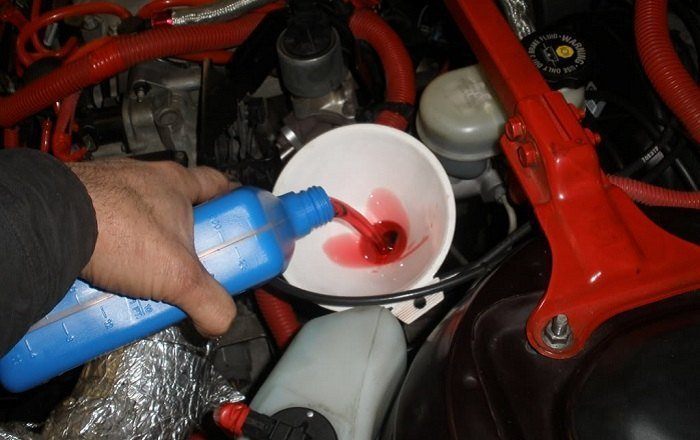by Joshua Thomas
Unless you are driving one of those modern electric vehicles, your car will use some type of transmission fluid to ensure the transmission system runs efficiently.
In many instances, when you talk about transmission fluid, it will often be referring to the fluid used on vehicles with an automatic transmission system. However, manual transmission systems also have transmission fluid.
Many vehicle owners will often choose to have a professional mechanic change the fluid for them, but this typically costs hundreds of dollars. The good news is that almost anyone can add transmission fluid, and you only need to know how to it properly.
Contents

Before you add transmission fluid to your vehicle, you first need to check and determine whether there is enough or not to ensure you do not do it when you do not have to. And this is also quite an easy process that should not take a lot of your time.
What You Need
Step by Step Directions
Before you can check the fluid level, you will need to first pack the vehicle in a level surface. And if you have a manual transmission system, it is advisable to go through all the gears before shifting to the park.
Also, remember that the engine has to be running to check the fluid level, otherwise you will not get accurate readings. Hence, after parking the vehicle on a level surface, you need to let it idle.
The next step is to pop the hood open using the lever or switch inside the car, and if the hood is not designed to stay in place on its own, you should look for a metal bar to hold it in place.
When you pop the hood, you should be able to locate the automatic fluid pipe, but because it is often out of sight, you should be ready to search a moment before locating it. And if you are not sure what it looks like or where it is located, your vehicle's manual will be very useful.
Next, pull out the dipstick but before doing this, you need to get a paper towel ready. And as you are pulling out the dipstick you should use the free hand to grip it and then wipe it with the rag to clean any fluid on it.
To check the transmission fluid level accurately, you should reinsert the dipstick all the way and then pull it out. For most dipsticks, there will be two lines that can either be "full" and "add" or "hot" and "cold".
If the transmission fluid id between the two lines, it means it is okay but if it is below the bottom line, you need to add more fluid

Once you determine that you are running out of transmission fluid, the next step is to add more fluid, and for the automatic transmission vehicles, this will be a more straightforward affair.
For the manual ones, it will take a little extra effort, but you should still be able to do it if you know what to do.
The first step should always be to choose the right transmission fluid for your vehicle, and here you may need to consult your owner's manual. And if this does not make it clear enough, the other good idea is to consult your mechanic.
Also, the dipstick on your transmission fluid pipe can tell you or at least give you some idea on the kind of fluid that you need if it is indicated or by looking at what is currently on the vehicle.
Besides checking the fluid type to use, you also need to determine how frequently you will need to change it.
Many people will add more fluid only when it is getting low, but many manufacturers will recommend to do it after a specific distance, which for most vehicles is between 30,000 and 100,000 miles.
Now pour in the transmission fluid, and for this most vehicles will need a longer funnel. Here you will only need to insert the funnel into the tube and then start pouring a small amount of the fluid into the pipe.
As you add the transmission fluid, it is important to keep on checking the level to ensure that you only add enough to get it to between the two lines.
Also, add the fluid as the engine is running and at the proper gear to ensure you get a more accurate level indication.
In case the transmission fluid has been drained completely, you will need between 4 and 12 quarts to fill it back up for most vehicles.
Lastly, it is also important to check for leaks because in some instances a leaking pipe might be the only reason why you are running out of transmission fluid fast.
If there are no leaks in the system and you are certain that you have enough transmission fluid in the system, the next step is to circulate it throughout the system to ensure it gets to all the important places.
To do this, you should keep one foot firmly on the brake and then run the transmission system through all the gears.
The last step is to check the dipstick again just to be sure that there is enough transmission fluid in there. And this is vital because shifting the gears can sometimes cause the fluid level to drop. If you find that the level has decreased significantly, you need to add more.

It is possible to own a vehicle without ever having to change the transmission fluid for its lifetime. However, depending on your vehicle make and model you might need to flush it after every few thousand miles or top it up.
Sometimes, a leak can result in low levels of transmission fluid and hence requiring you to add more.
With that said, you need to watch out for the different signs and symptoms that will let you know when you need to add more transmission fluid.
Besides transferring power from the engine to the wheels, another important function of the transmission fluid is to keep the transmission system cool.
Hence, when there is not enough of it in the system, there will be more friction which leads to excessive production of heat which then overheats the transmission system and diminishes its performance.
When you engage a gear and it slips, and this is more so for those that have vehicles with manual transmission systems, this can be a sign that your transmission system is running low on fluid and you need to add more.
If the fluid is low, it will not allow the gear to remain in the mode that you choose. But, if the gear still slips and you are sure the fluid level is right, the other possible explanation is that there is a residue buildup that prevents it from flowing freely.
When your vehicle has enough transmission fluid and the system is working smoothly, gear engagement should be a smooth process with no delays.
However, low fluid levels will result in low pressure which in turn causes a delay in the gear change. In such instances, the response time can be upwards of 3 seconds, which should be enough to tell you that you need to add more transmission fluid.
Erratic shifts, which is where the gear shift will happen to early or too late, is another good indication that your transmission fluid needs some checking.
The hydraulic pressure in a transmission system needs to precise and smooth, and any disruptions in the system due to low transmission fluid can cause erratic shifts. What all this means is an erratic shift pattern will be a perfect indication of low transmission fluid.
Whether you are driving an automatic or manual vehicle, gunk or dirt in your transmission fluid will lead to a sluggish response. Sluggish response or difficulties shifting gears will also occur when you are running low on transmission fluid.
Transmission fluid plays a crucial role in your vehicle as it ensures smooth rides and keeps your vehicle at peak performance.
And while it will be a long time before you need to add more transmission fluid to your car and sometimes you might not even have to for the time you have it, it is still worth knowing how to do it.
The good news is that it is quite straightforward as you will only need to choose the right type, check the level and then pour the fluid into the tube using a funnel.
Also, make sure to watch out for signs that you need to add more transmission fluid such as erratic gear shifts and overheating of the transmission system.
Sources
 |
 |
 |
 |

About Joshua Thomas
Joshua Thomas just simply loves cars and willing to work on them whenever there's chance... sometimes for free.
He started CarCareTotal back in 2017 from the advices of total strangers who witnessed his amazing skills in car repairs here and there.
His goal with this creation is to help car owners better learn how to maintain and repair their cars; as such, the site would cover alot of areas: troubleshooting, product recommendations, tips & tricks.
Joshua received Bachelor of Science in Mechanical Engineering at San Diego State University.
Just Car Care